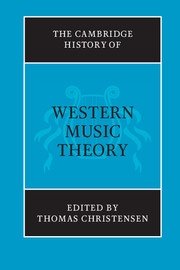Book contents
- Frontmatter
- Introduction
- PART I DISCIPLINING MUSIC THEORY
- PART II SPECULATIVE TRADITIONS
- PART III REGULATIVE TRADITIONS
- A Mapping tonal spaces
- B Compositional Theory
- C Time
- 20 The evolution of rhythmic notation
- 21 Theories of musical rhythm in the eighteenth and nineteenth centuries
- 22 Rhythm in twentieth-century theory
- D Tonality
- PART IV DESCRIPTIVE TRADITIONS
- Index of authors
- Index of subjects
- References
22 - Rhythm in twentieth-century theory
from C - Time
Published online by Cambridge University Press: 28 March 2008
- Frontmatter
- Introduction
- PART I DISCIPLINING MUSIC THEORY
- PART II SPECULATIVE TRADITIONS
- PART III REGULATIVE TRADITIONS
- A Mapping tonal spaces
- B Compositional Theory
- C Time
- 20 The evolution of rhythmic notation
- 21 Theories of musical rhythm in the eighteenth and nineteenth centuries
- 22 Rhythm in twentieth-century theory
- D Tonality
- PART IV DESCRIPTIVE TRADITIONS
- Index of authors
- Index of subjects
- References
Summary
We have seen in the previous chapter how Riemann attempted to consolidate various trends in nineteenth-century rhythmic theory, synthesizing rhythm, meter, agogics, and phrase structure within his overarching theory of harmonic functionality. As was perhaps inevitable with such a comprehensive project, various tensions and problems remained in Riemann’s mature theory. Many early twentieth-century theorists such as August Halm, Ernst Kurth, and Hans Mersmann were critical of Riemann’s accentual theory, and so in part the history of rhythmic theory, at least at the beginning of the century, can be characterized as “a reaction to Riemann.” In addition, there were other musical and intellectual developments which shaped twentieth-century rhythmic theory, among which can be mentioned:
1. There were new ideas of motion and time, from physics, philosophy, and psychology, that led a number of theorists to place musical energetics and motion at the center of their approach to rhythm.
2. Schenker’s theory of tonality and tonal dynamics influenced a number of approaches to rhythm and the temporal unfolding of musical events, especially amongst North American theorists in the second half of the century.
3. Developments in linguistics and gestalt psychology influenced “architectonic” approaches to rhythm, engendering structuralist theories that emphasize the hierarchical aspects of rhythm and form.
4. Radical changes in musical style, especially the rise of atonality and serialism, demanded new conceptions of rhythm and meter. This led to various prescriptive theories of rhythm that were often developed (and commented upon) by the composers themselves.
This chapter will selectively review the work of theorists and musicians from each of these four areas.
- Type
- Chapter
- Information
- The Cambridge History of Western Music Theory , pp. 695 - 725Publisher: Cambridge University PressPrint publication year: 2002
References
- 3
- Cited by



